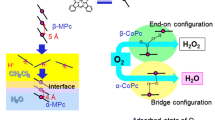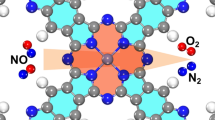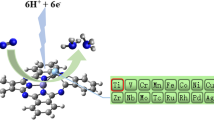Abstract
This paper investigates about the theoretical study on center and edge site interaction of carbon dioxide and water molecules with amine (NH2)-, methyl (CH3)-, hydroxyl (OH)-, aldehyde (CHO)- and carboxyl (COOH)- functionalized Magnesium (Mg) and Scandium (Sc) phthalocyanines. The study shows that the gas molecules are physisorbed over the Pcs through electrostatic interactions, while weak interactions occur at the edges. The perpendicular orientation of CO2 shows stronger interaction while the adsorption is greater for H2O having out-of-plane orientation. The binding of CO2 molecule stems via a simultaneous charge transfer from the metal center to the oxygen atom of the CO2 molecule in addition to a donation from the N–C bond of the Pc to the Lewis acidic carbon atom of the CO2 molecule. The peak splitting in bending frequency of the adsorbed CO2 molecule is maximum, and the asymmetric stretching frequency is blueshifted in the case of (CHO)16 Sc-Pc and (COOH)16 Sc-Pc in which the interaction energy is higher. The interaction of H2O molecule increases the stability of phthalocyanines thereby imparting practicality in using them under humid conditions. The interaction of Pcs with water is more feasible and spontaneous, whereas Sc metal induces feasibility to adsorb CO2 as well. In the case of functionalized MgPcs with CO2, the interactions are possible below the room temperature. The adsorption capacity shows that a lesser number of gas molecules adsorb at the metal center while more number of weakly bound gas molecules adsorb at the edges. Overall, the study concludes that scandium substitution at center and functionalization of acceptor molecules such as CHO and COOH at the edges in M-Pcs shows greater ability toward gas adsorption.






Similar content being viewed by others
References
Bui M, Adjiman CS, Bardow A, Anthony EJ, Boston A, Brown S, Fennell PS, Fuss S, Galindo A, Hackett LA, Hallett JP, Herzog HJ, Jackson G, Kemper J, Krevor S, Maitland GC, Matuszewski M, Metcalfe IS, Petit C, Puxty G, Reimer J, Reiner DM, Rubin ES, Scott SA, Shah N, Smit B, Trusler JPM, Webley P, Wilcox J, Mac Dowell N (2018) Carbon capture and storage (CCS): the way forward. Energy Environ Sci 11(5):1062–1176. https://doi.org/10.1039/c7ee02342a
Chaffee AL, Knowles GP, Liang Z, Zhang J, Xiao P, Webley PA (2007) CO2 capture by adsorption: materials and process development. Int J Greenhouse Gas Control 1(1):11–18. https://doi.org/10.1016/S1750-5836(07)00031-X
Koytsoumpa EI, Bergins C, Kakaras E (2018) The CO2 economy: review of CO2 capture and reuse technologies. J Supercrit Fluids 132:3–16. https://doi.org/10.1016/j.supflu.2017.07.029
Li J, Hou Y, Wang P, Yang B (2018) A review of carbon capture and storage project investment and operational decision-making based on bibliometrics. Energies. https://doi.org/10.3390/en12010023
Vitillo JG, Smit B, Gagliardi L (2017) Introduction: carbon capture and separation. Chem Rev 117(14):9521–9523. https://doi.org/10.1021/acs.chemrev.7b00403
Melnikov SM, Stein M (2019) The effect of CO2 loading on alkanolamine absorbents in aqueous solutions. Phys Chem Chem Phys. https://doi.org/10.1039/c9cp03976g
Arstad B, Blom R, Swang O (2007) CO2 absorption in aqueous solutions of alkanolamines: mechanistic insight from quantum chemical calculations. J Phys Chem A 111(7):1222–1228. https://doi.org/10.1021/jp065301v
Liu S, Ling H, Gao H, Tontiwachwuthikul P, Liang Z (2019) Better choice of tertiary alkanolamines for postcombustion CO2 capture: structure with linear alkanol chain instead of branched. Ind Eng Chem Res. https://doi.org/10.1021/acs.iecr.9b02244
Fan Y, Rezaei F, Yang X (2019) Mixed Alkanolamine-polyethylenimine functionalized silica for CO2 capture. Energy Technol 7(2):253–262. https://doi.org/10.1002/ente.201800481
Huang Q, Luo Q, Wang Y, Pentzer E, Gurkan B (2019) Hybrid ionic liquid capsules for rapid CO2 capture. Ind Eng Chem Res 58(24):10503–10509. https://doi.org/10.1021/acs.iecr.9b00314
Zulfiqar S, Mantione D, El Tall O, Ruipérez F, Sarwar MI, Rothenberger A, Mecerreyes D (2019) Pyridinium containing amide based polymeric ionic liquids for CO2/CH4 separation. ACS Sustain Chem Eng 7(12):10241–10247. https://doi.org/10.1021/acssuschemeng.9b01903
Wang Y, Zheng C, Wang Y, Chen H, Xu Y (2019) Thermodynamic validation of double bond comprised ionic liquids for CO2 capture. J Environ Chem Eng 7(1):102774. https://doi.org/10.1016/j.jece.2018.11.019
Xiao M, Liu H, Gao H, Olson W, Liang Z (2019) CO2 capture with hybrid absorbents of low viscosity imidazolium-based ionic liquids and amine. Appl Energy 235:311–319. https://doi.org/10.1016/j.apenergy.2018.10.103
Yang Z-z, Wei J-j, Zeng G-m, Zhang H-q, Tan X-f, Ma C, Li X-c, Li Z-h, Zhang C (2019) A review on strategies to LDH-based materials to improve adsorption capacity and photoreduction efficiency for CO2. Coord Chem Rev 386:154–182. https://doi.org/10.1016/j.ccr.2019.01.018
Baena-Moreno FM, Rodríguez-Galán M, Vega F, Alonso-Fariñas B, Vilches Arenas LF, Navarrete B (2019) Carbon capture and utilization technologies: a literature review and recent advances. Energy Sources Part A Recovery Util Environ Effects 41(12):1403–1433. https://doi.org/10.1080/15567036.2018.1548518
Tahir Z, Aslam M, Gilani MA, Bilad MR, Anjum MW, Zhu L-P, Khan AL (2019) SO3H functionalized UiO-66 nanocrystals in Polysulfone based mixed matrix membranes: Synthesis and application for efficient CO2 capture. Sep Purif Technol 224:524–533. https://doi.org/10.1016/j.seppur.2019.05.060
Shi X, Xiao H, Azarabadi H, Song J, Wu X, Chen X, Lackner KS (2019) Sorbents for direct capture of CO2 from ambient air. Angew Chem Int Ed. https://doi.org/10.1002/anie.201906756
Yang L, Shi C, Li L, Li Y (2019) High-throughput model-building and screening of zeolitic imidazolate frameworks for CO2 capture from flue gas. Chin Chem Lett. https://doi.org/10.1016/j.cclet.2019.04.025
Azmi AA, Aziz MAA (2019) Mesoporous adsorbent for CO2 capture application under mild condition: a review. J Environ Chem Eng 7(2):103022. https://doi.org/10.1016/j.jece.2019.103022
Hu Z, Wang Y, Shah BB, Zhao D (2019) CO2 capture in metal-organic framework adsorbents: an engineering perspective. Adv Sustain Syst 3(1):1800080. https://doi.org/10.1002/adsu.201800080
Leperi KT, Chung YG, You F, Snurr RQ (2019) Development of a general evaluation metric for rapid screening of adsorbent materials for postcombustion CO2 capture. ACS Sustain Chem Eng 7(13):11529–11539. https://doi.org/10.1021/acssuschemeng.9b01418
Jiang Y, Tan P, Qi S-C, Liu X-Q, Yan J-H, Fan F, Sun L-B (2019) Metal-organic frameworks with target-specific active sites switched by photoresponsive motifs: efficient adsorbents for tailorable CO2 capture. Angew Chem Int Ed 58(20):6600–6604. https://doi.org/10.1002/anie.201900141
Valenzano L, Civalleri B, Chavan S, Palomino GT, Areán CO, Bordiga S (2010) Computational and experimental studies on the adsorption of CO, N2, and CO2 on Mg-MOF-74. J Phys Chem C 114(25):11185–11191. https://doi.org/10.1021/jp102574f
He R, Cong S, Wang J, Liu J, Zhang Y (2019) Porous graphene oxide/porous organic polymer hybrid nanosheets functionalized mixed matrix membrane for efficient CO2 capture. ACS Appl Mater Interfaces 11(4):4338–4344. https://doi.org/10.1021/acsami.8b17599
S Aquino A, O Vieira M, Ferreira SDA, Cabrita JE, Einloft S, O de Souza M (2019) Hybrid ionic liquid-silica xerogels applied in CO2 capture. Appl Sci 9(13):2614. https://doi.org/10.3390/app9132614
Vieillard J, Bouazizi N, Bargougui R, Fotsing PN, Thoumire O, Ladam G, Brun N, Hochepied JF, Woumfo ED, Mofaddel N, Derf FL, Azzouz A (2019) Metal-inorganic-organic core–shell material as efficient matrices for CO2 adsorption: synthesis, properties and kinetic studies. J Taiwan Inst Chem Eng 95:452–465. https://doi.org/10.1016/j.jtice.2018.08.020
Neti VSPK, Wang J, Deng S, Echegoyen L (2015) High and selective CO2 adsorption by a phthalocyanine nanoporous polymer. J Mater Chem A 3(19):10284–10288. https://doi.org/10.1039/c5ta00587f
Hohnholz D, Steinbrecher S, Hanack M (2000) Applications of phthalocyanines in organic light emitting devices. In honour of Professor Giuseppe Zerbi on the occasion of his 65th birthday. J Mol Struct 521(1):231–237. https://doi.org/10.1016/S0022-2860(99)00438-X
Doyle JJ, Wang J, O’Flaherty SM, Chen Y, Slodek A, Hegarty T, Carpenter Ii LE, Wöhrle D, Hanack M, Blau WJ (2008) Nonlinear optical performance of chemically tailored phthalocyanine–polymer films as solid-state optical limiting devices. J Opt A Pure Appl Opt 10(7):075101. https://doi.org/10.1088/1464-4258/10/7/075101
Zhang Y, Lovell JF (2017) Recent applications of phthalocyanines and naphthalocyanines for imaging and therapy. Wiley Interdiscip Rev Nanomed Nanobiotechnol 9(1):e1420. https://doi.org/10.1002/wnan.1420
Li X, Peng X-H, Zheng B-D, Tang J, Zhao Y, Zheng B-Y, Ke M-R, Huang J-D (2018) New application of phthalocyanine molecules: from photodynamic therapy to photothermal therapy by means of structural regulation rather than formation of aggregates. Chem Sci 9(8):2098–2104. https://doi.org/10.1039/c7sc05115h
Cole A, McIlroy RJ, Thorpe SC, Cook MJ, McMurdo J, Ray AK (1993) Substituted phthalocyanine gas sensors. Sens Actuators B Chem 13(1):416–419. https://doi.org/10.1016/0925-4005(93)85415-7
Rana MK, Sinha M, Panda S (2018) Gas sensing behavior of metal-phthalocyanines: effects of electronic structure on sensitivity. Chem Phys 513:23–34. https://doi.org/10.1016/j.chemphys.2018.06.021
Bohrer FI, Sharoni A, Colesniuc C, Park J, Schuller IK, Kummel AC, Trogler WC (2007) Gas sensing mechanism in chemiresistive cobalt and metal-free phthalocyanine thin films. J Am Chem Soc 129(17):5640–5646. https://doi.org/10.1021/ja0689379
Zou D, Zhao W, Cui B, Li D, Liu D (2018) Adsorption of gas molecules on a manganese phthalocyanine molecular device and its possibility as a gas sensor. Phys Chem Chem Phys 20(3):2048–2056. https://doi.org/10.1039/c7cp06760g
Lü K, Zhou J, Zhou L, Chen XS, Chan SH, Sun Q (2012) Pre-combustion CO2 capture by transition metal ions embedded in phthalocyanine sheets. J Chem Phys 136(23):234703. https://doi.org/10.1063/1.4729471
Arokiyanathan AL, Lakshmipathi S (2018) Theoretical study on the interaction of CO2 and H2O molecules with metal doped-fluorinated phthalocyanines. New J Chem 42(5):3465–3472. https://doi.org/10.1039/c7nj03662k
Shen H, Li Y, Sun Q (2017) CO2 electroreduction performance of phthalocyanine sheet with Mn dimer: a theoretical study. J Phys Chem C 121(7):3963–3969. https://doi.org/10.1021/acs.jpcc.7b00317
Goodarzi M, Nazari F, Illas F (2018) Assessing the performance of cobalt phthalocyanine nanoflakes as molecular catalysts for Li-promoted oxalate formation in Li–CO2–oxalate batteries. J Phys Chem C 122(45):25776–25784. https://doi.org/10.1021/acs.jpcc.8b06395
Han N, Wang Y, Ma L, Wen J, Li J, Zheng H, Nie K, Wang X, Zhao F, Li Y, Fan J, Zhong J, Wu T, Miller DJ, Lu J, Lee S-T, Li Y (2017) supported cobalt polyphthalocyanine for high-performance electrocatalytic CO2 reduction. Chem 3(4):652–664. https://doi.org/10.1016/j.chempr.2017.08.002
Arokiyanathan AL, Lakshmipathi S (2018) Impact of functional groups substitution on the molecular properties of magnesium and scandium phthalocyanines. Inorg Chim Acta 483:203–210. https://doi.org/10.1016/j.ica.2018.07.043
Becke AD (1993) Density-functional thermochemistry. III. The role of exact exchange. J Chem Phys 98(7):5648–5652. https://doi.org/10.1063/1.464913
Grimme S, Antony J, Ehrlich S, Krieg H (2010) A consistent and accurate ab initio parametrization of density functional dispersion correction (DFT-D) for the 94 elements H-Pu. J Chem Phys 132(15):154104. https://doi.org/10.1063/1.3382344
Hay PJ, Wadt WR (1985) Ab initio effective core potentials for molecular calculations. Potentials for K to Au including the outermost core orbitals. J Chem Phys 82(1):299–310. https://doi.org/10.1063/1.448975
Hay PJ, Wadt WR (1985) Ab initio effective core potentials for molecular calculations. Potentials for the transition metal atoms Sc to Hg. J Chem Phys 82(1):270–283. https://doi.org/10.1063/1.448799
Frisch MJ, Trucks GW, Schlegel HB, Scuseria GE, Robb MA, Cheeseman JR, Scalmani G, Barone V, Mennucci B, Petersson GA, Nakatsuji H, Caricato M, Li X, Hratchian HP, Izmaylov AF, Bloino J, Zheng G, Sonnenberg JL, Hada M, Ehara M, Toyota K, Fukuda R, Hasegawa J, Ishida M, Nakajima T, Honda Y, Kitao O, Nakai H, Vreven T, Montgomery JA Jr, Peralta JE, Ogliaro F, Bearpark MJ, Heyd J, Brothers EN, Kudin KN, Staroverov VN, Kobayashi R, Normand J, Raghavachari K, Rendell AP, Burant JC, Iyengar SS, Tomasi J, Cossi M, Rega N, Millam NJ, Klene M, Knox JE, Cross JB, Bakken V, Adamo C, Jaramillo J, Gomperts R, Stratmann RE, Yazyev O, Austin AJ, Cammi R, Pomelli C, Ochterski JW, Martin RL, Morokuma K, Zakrzewski VG, Voth GA, Salvador P, Dannenberg JJ, Dapprich S, Daniels AD, Farkas Ö, Foresman JB, Ortiz JV, Cioslowski J, Fox DJ (2009) Gaussian 09. Gaussian Inc, Wallingford, CT, USA
Bader RFW (1991) A quantum theory of molecular structure and its applications. Chem Rev 91(5):893–928. https://doi.org/10.1021/cr00005a013
Lu T, Chen F (2012) Multiwfn: a multifunctional wavefunction analyzer. J Comput Chem 33(5):580–592. https://doi.org/10.1002/jcc.22885
Popelier P, Popelier PLA (2000) Atoms in molecules: an introduction. Prentice Hall, New Jersey
Popelier PLA, Bader RFW (1992) The existence of an intramolecular C–H–O hydrogen bond in creatine and carbamoyl sarcosine. Chem Phys Lett 189(6):542–548. https://doi.org/10.1016/0009-2614(92)85247-8
Koch U, Popelier PLA (1995) Characterization of C–H–O hydrogen bonds on the basis of the charge density. J Phys Chem 99(24):9747–9754. https://doi.org/10.1021/j100024a016
Kim D, Park J, Kim YS, Lah MS (2017) Temperature dependent CO2 behavior in microporous 1-D channels of a metal-organic framework with multiple interaction sites. Sci Rep 7:41447. https://doi.org/10.1038/srep41447
Reed AE, Curtiss LA, Weinhold F (1988) Intermolecular interactions from a natural bond orbital, donor-acceptor viewpoint. Chem Rev 88(6):899–926. https://doi.org/10.1021/cr00088a005
Szatyłowicz H, Krygowski TM, Panek JJ, Jezierska A (2008) H-bonded complexes of aniline with HF/F− and anilide with HF in terms of symmetry-adapted perturbation, atoms in molecules, and natural bond orbitals theories. J Phys Chem A 112(40):9895–9905. https://doi.org/10.1021/jp803592v
Dietzel PDC, Johnsen RE, Fjellvåg H, Bordiga S, Groppo E, Chavan S, Blom R (2008) Adsorption properties and structure of CO2 adsorbed on open coordination sites of metal–organic framework Ni2(dhtp) from gas adsorption, IR spectroscopy and X-ray diffraction. Chem Commun 41:5125–5127. https://doi.org/10.1039/b810574j
Queen WL, Hudson MR, Bloch ED, Mason JA, Gonzalez MI, Lee JS, Gygi D, Howe JD, Lee K, Darwish TA, James M, Peterson VK, Teat SJ, Smit B, Neaton JB, Long JR, Brown CM (2014) Comprehensive study of carbon dioxide adsorption in the metal–organic frameworks M2(dobdc) (M = Mg, Mn, Fe Co, Ni, Cu, Zn). Chem Sci 5(12):4569–4581. https://doi.org/10.1039/c4sc02064b
Lin X, Ni J, Fang C (2013) Adsorption capacity of H2O, NH3, CO, and NO2 on the pristine graphene. J Appl Phys 113(3):034306. https://doi.org/10.1063/1.4776239
Yu J, Balbuena PB (2013) Water effects on postcombustion CO2 capture in Mg-MOF-74. J Phys Chem C 117(7):3383–3388. https://doi.org/10.1021/jp311118x
Zuluaga S, Fuentes-Fernandez EMA, Tan K, Xu F, Li J, Chabal YJ, Thonhauser T (2016) Understanding and controlling water stability of MOF-74. J Mater Chem A 4(14):5176–5183. https://doi.org/10.1039/C5TA10416E
Acknowledgements
This work was supported by INSPIRE program under the Department of Science and Technology, India [DST/INSPIRE Fellowship/2015/IF150672].
Author information
Authors and Affiliations
Corresponding author
Ethics declarations
Conflict of interest
The authors declare no conflict of interest.
Additional information
Publisher's Note
Springer Nature remains neutral with regard to jurisdictional claims in published maps and institutional affiliations.
Supplementary Information
Below is the link to the electronic supplementary material.
Rights and permissions
About this article
Cite this article
Arokiyanathan, A.L., Lakshmipathi, S. Theoretical perspective on the interaction of CO2 and H2O molecules with functionalized magnesium and scandium phthalocyanines. Theor Chem Acc 140, 36 (2021). https://doi.org/10.1007/s00214-021-02732-1
Received:
Accepted:
Published:
DOI: https://doi.org/10.1007/s00214-021-02732-1




